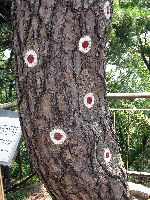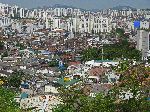Ibike Korea People-to-People Program
 Photo essay: Seoul
City Fortress Wall
Photo essay: Seoul
City Fortress Wall
(Northern Half)
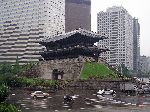
 Namdaemun (South Gate)
is appropriately named because it was literally the south gate into the city
through the old Fortress Wall.
Namdaemun is National Treasure number 1. What once marked the edge of the city has
long since been engulfed by it, but that hardly diminishes its elegance. In 2004, it sat inside a traffic circle (left) with five
lanes of traffic continually swirling around it. By 2006 it had been "rescued"
(upper right). All of the traffic is diverted to west flank of the gate
and pedestrians have access to the
gate from the east. The regular "changing of the guard" ceremony
was restored, as well.
Namdaemun (South Gate)
is appropriately named because it was literally the south gate into the city
through the old Fortress Wall.
Namdaemun is National Treasure number 1. What once marked the edge of the city has
long since been engulfed by it, but that hardly diminishes its elegance. In 2004, it sat inside a traffic circle (left) with five
lanes of traffic continually swirling around it. By 2006 it had been "rescued"
(upper right). All of the traffic is diverted to west flank of the gate
and pedestrians have access to the
gate from the east. The regular "changing of the guard" ceremony
was restored, as well.
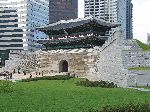 Ironically
its 'rescue' may have facilitated its demise because in 2010 it was
torched by an arsonist. To find, collect and properly cure the old growth
timber need for and authentic restoration of the structure took several years.
Fortunately the construction fences came down in 2013 and the gate is again
visible. While it is accessible to visitors, it is now difficult to get to
any part of it that might be flammable.
Ironically
its 'rescue' may have facilitated its demise because in 2010 it was
torched by an arsonist. To find, collect and properly cure the old growth
timber need for and authentic restoration of the structure took several years.
Fortunately the construction fences came down in 2013 and the gate is again
visible. While it is accessible to visitors, it is now difficult to get to
any part of it that might be flammable.
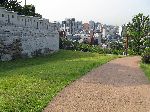
The journey begins near what would be the west gate and travels clockwise around the city to the existing East Gate.
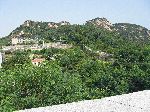
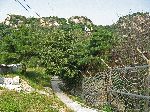 Along the northern arc, it turns out that there is not only an old wall but also
a "new wall" as well. Much of this section is a formally designated military
zone. To walk one section you need to register, present a passport and receive
an ID badge to wear around your neck. Who knows what all of the aspects of
the "new wall" are: In some places there are chain link and barbwire fences. In
other places you get a glimpse of an occupied outpost or see the tip of an
anti-aircraft gun. There are section were the woods seem to be filled with
electronic devices and these are probably only the tip of the ice berg.
There are plenty of signs indicating no photography and keeping you on the
trail.
Along the northern arc, it turns out that there is not only an old wall but also
a "new wall" as well. Much of this section is a formally designated military
zone. To walk one section you need to register, present a passport and receive
an ID badge to wear around your neck. Who knows what all of the aspects of
the "new wall" are: In some places there are chain link and barbwire fences. In
other places you get a glimpse of an occupied outpost or see the tip of an
anti-aircraft gun. There are section were the woods seem to be filled with
electronic devices and these are probably only the tip of the ice berg.
There are plenty of signs indicating no photography and keeping you on the
trail.
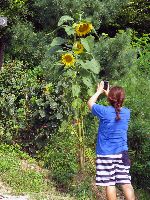
Awareness of the "new wall" made me reticent to take a lot of pictures that I
might have been able to. The "no photo" signs weren't specific about what
distance and what direction they applied, and there we long stretches without
any signs. Until I was most of the way along the trail and saw others take
pictures in areas with no signs I wasn't embolden to record some of these
perspectives.
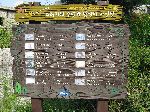
The human side of the trail include an environmental awareness signs which listed how long various types of litter last: cigarette butts - 1-5 yrs, plastic bags 10-20 yrs, nylon fabric 30-40 yrs, tin cans -- 50 years, aluminum cans -500 yrs, glass bottles -- 1000 yrs, plastic containers and Styrofoam -- indefinitely!
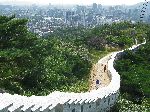
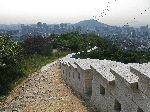
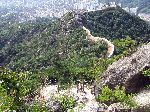 Part
of the interest of the trip is the wall itself and it snakes along up the
ridgeline, over peaks and across the next saddle, then through a tranquil forest.
It is sort of a contradiction to its reason for being.
Part
of the interest of the trip is the wall itself and it snakes along up the
ridgeline, over peaks and across the next saddle, then through a tranquil forest.
It is sort of a contradiction to its reason for being.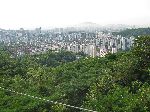
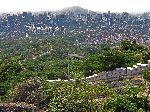
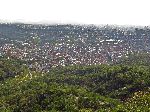
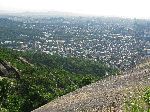
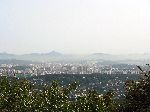
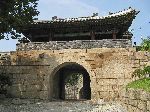
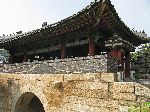 Changuimun
is one of "Four Small Gates" (Sasomun) of the Fortress Wall. It is located
northwest of downtown Seoul. This served as a major link to the north.
The gatehouse was burnt down during the Imjin Waeran (Japanese invasion of Korea
in 1592.) The gatehouse was rebuilt about 1740. The gatehouse is
currently the oldest gatehouse of the Sasomun. Visitors are allowed to visit
around the gate, but not enter inside. Attempting to do so will set off a
laser alarm system!
Changuimun
is one of "Four Small Gates" (Sasomun) of the Fortress Wall. It is located
northwest of downtown Seoul. This served as a major link to the north.
The gatehouse was burnt down during the Imjin Waeran (Japanese invasion of Korea
in 1592.) The gatehouse was rebuilt about 1740. The gatehouse is
currently the oldest gatehouse of the Sasomun. Visitors are allowed to visit
around the gate, but not enter inside. Attempting to do so will set off a
laser alarm system!From here the wall goes up over Bugaksan.
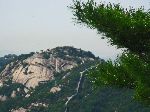
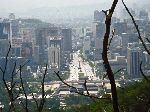 Baegaksan
(Mt.) (now called Bugaksan) was chosen as the Jusan (guardian mountain of a
city) when Hanyang (Seoul) was chosen as the capital city of Joseon.
Hanyang was situated so that the Jusan Baegaksan was the northern boundary and
Mongmyeoksan (present Namsan) was its southern boundary. Naksan, to the
east, was seen as the Eastern Blue Dragon (one of the four celestial animals in
Fengshui). Inwagsan, to the west, was seen as the Western White Tiger. The
main palace, Gyeongbokgung, was built on the lower slope of Baegaksan, the
guardian mountain and the rest of the city was built out from there.
Baegaksan
(Mt.) (now called Bugaksan) was chosen as the Jusan (guardian mountain of a
city) when Hanyang (Seoul) was chosen as the capital city of Joseon.
Hanyang was situated so that the Jusan Baegaksan was the northern boundary and
Mongmyeoksan (present Namsan) was its southern boundary. Naksan, to the
east, was seen as the Eastern Blue Dragon (one of the four celestial animals in
Fengshui). Inwagsan, to the west, was seen as the Western White Tiger. The
main palace, Gyeongbokgung, was built on the lower slope of Baegaksan, the
guardian mountain and the rest of the city was built out from there.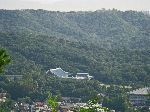
There is a tree on Bugaksan that was hit by bullets as part of the aftermath of the Blue House Raid in January, 1968. The Blue House Raid involved thirty-one handpicked commandos from the elite all-officer Unit 124 of the Korean People's Army (KPA). This special operation unit trained for two years and spent their final 15 days rehearsing action on the objective in a full-scale mockup of the Blue House. After infiltrating the DMZ on January 19, the plan began to unravel when four brothers out cutting firewood stumbled across the commandos camp. The brothers reported the presence of the insurgents to the police station in Beopwon-ri. The raiders broke camp, quickly head south and slit up into cells as the neared Seoul. They regroup the next day at Seungga-sa Temple, where they made final preparations for the assault. Meanwhile, the South Korean Army (ROKA) and police were undertaking a massive search for the stealthy team, who had changed into ROKA uniforms. On January 21, they formed up and prepared to march the last mile to the Blue House, posing as ROKA soldiers returning from a counter-infiltration patrol. The disguised assasin unit marched along Segeomjeong Road toward the Blue House, they passing several National Police and ROKA units heading out. At a checkpoint less than 100 meters from the Blue House the Jongro Polic Chief, Choi Gyushik (a national hero), approached the unit and began to question them. When he grew suspicious of their answers, he drew his pistol and was shot by a commando. After a short firefight the KPA unit dispersed. Over the next eight days 29 members of Unit 124 were killed, one was captured, and the other was presumed to have returned to North Korea. South Korean causualties total 26 killed and 66 wounded.
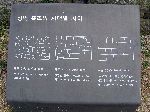
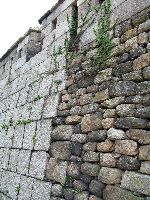 Here
is a guide to the different construction techniques for the wall in the 14th,
15th and 18th centuries. There are a lot of places were you can see the
different patterns in close proximity to each other. The conclusion would
be, as specific sections of the wall deteriorated they would rebuild those
segments.
Here
is a guide to the different construction techniques for the wall in the 14th,
15th and 18th centuries. There are a lot of places were you can see the
different patterns in close proximity to each other. The conclusion would
be, as specific sections of the wall deteriorated they would rebuild those
segments.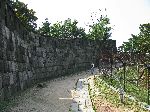
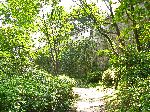 The section
(left) includes old
wall, new wall and electronic wall.
The section
(left) includes old
wall, new wall and electronic wall.Generally the trail was on top of the wall or parallel the wall on the inside. The section (right) had the trail on the outside. There were indication that the area inside the wall were being used for other purposes that weren't so bucolic.
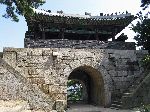
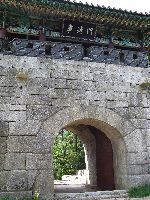
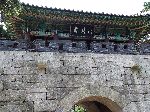 Unlike
the Northwest Gate and the Northeast Gate, which are at points where the ridge
is low, and were heavily used, the North Gate, Sukjeongmun, is located where the
ridge is high, behind the main royal palace and hardly used except for symbolic
functions. It was built, along with much of the rest of the this section
of the wall in 1396. At some point the wood pavilion burnt down and was rebuilt
in 1976.
Unlike
the Northwest Gate and the Northeast Gate, which are at points where the ridge
is low, and were heavily used, the North Gate, Sukjeongmun, is located where the
ridge is high, behind the main royal palace and hardly used except for symbolic
functions. It was built, along with much of the rest of the this section
of the wall in 1396. At some point the wood pavilion burnt down and was rebuilt
in 1976.According to the traditional theory of Yin, Yang and the Five Elements, the North Gate represented "water" and hence "shady energy." With this belief, during the Joseon period, when the nation was struck by drought, the North Gate was left open and the South Gate was closed.
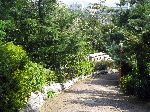
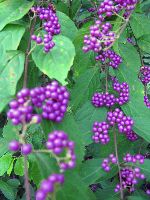
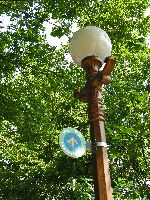
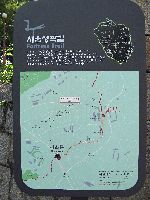 As
the ridge gets lower and the wall reenters more built-up parts of the city the
trail has a wider and smoother surface, there is more signage, some lighting and more
ornamental plants. The vistas of forests of trees are again replaced with
vistas of forests
of high-rise buildings.
As
the ridge gets lower and the wall reenters more built-up parts of the city the
trail has a wider and smoother surface, there is more signage, some lighting and more
ornamental plants. The vistas of forests of trees are again replaced with
vistas of forests
of high-rise buildings.Increasingly the wall is obliterated and the route follows city streets for sections. Even with more directional signage, as the route twists through city streets it can be hard to follow. Several different signage schemes are used and it is sometimes hare to connect-the-dots, so it is helpful to carry a map as well.
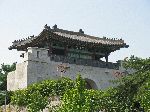
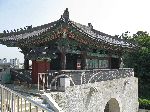
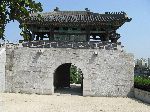 Hyehwamun
is one of the Four Small Gates (Samomun) of the fortress wall. It is in the
northeast section of the wall. The gatehouse was built in 1744, but was
demolished in 1928 due deterioration from age, leaving only the arched entrance.
The whole gate was destroyed during the Japanese Colonial Period to allow for
the construction of tram tracks. The current gate, restored in 1992, is slightly
north of the original site due to the road that passes it.
Hyehwamun
is one of the Four Small Gates (Samomun) of the fortress wall. It is in the
northeast section of the wall. The gatehouse was built in 1744, but was
demolished in 1928 due deterioration from age, leaving only the arched entrance.
The whole gate was destroyed during the Japanese Colonial Period to allow for
the construction of tram tracks. The current gate, restored in 1992, is slightly
north of the original site due to the road that passes it.The wall continues for about 2 km more. Most of the distance it is adjacent to school playgrounds, parks, greenbelts and low-rise residential areas, so it is a pleasant walk and used by local residents for recreation.
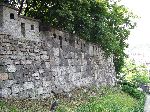
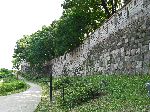
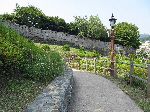
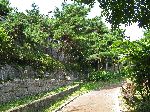
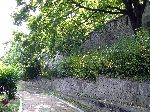
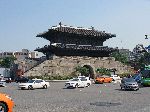
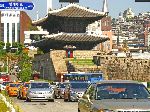 If
you continue to the end of the wall a couple hundred meters through streets that
join boulevards you will come to the ancient
Dongdaemun (the east gate). Once part of the City Fortress Wall that
encircled the city, it is now tucked into and engulfed by the city.
If
you continue to the end of the wall a couple hundred meters through streets that
join boulevards you will come to the ancient
Dongdaemun (the east gate). Once part of the City Fortress Wall that
encircled the city, it is now tucked into and engulfed by the city.This brings us a full half-circle around the city.
 Please
contact us if you would like to be added to
Ibike's mailing list or have questions, comments, corrections or criticism. (Also, please let us know how you learned about us and
found this site.) Privacy policy.
Please
contact us if you would like to be added to
Ibike's mailing list or have questions, comments, corrections or criticism. (Also, please let us know how you learned about us and
found this site.) Privacy policy.
![]() IBF Homepage
IBF Homepage ![]() Ibike Programs
Ibike Programs
![]() Ibike Schedule
Ibike Schedule
![]() Search
Search
